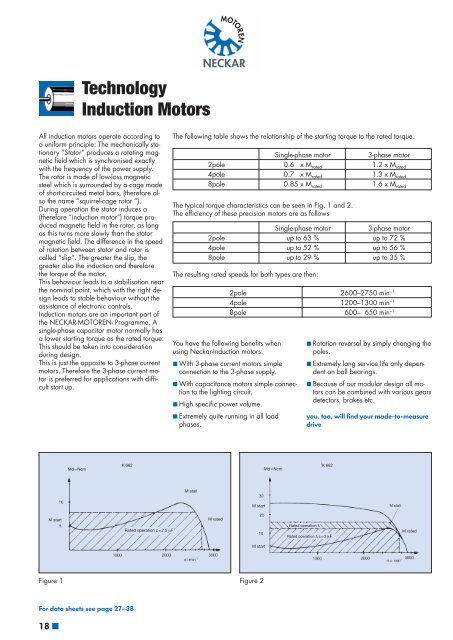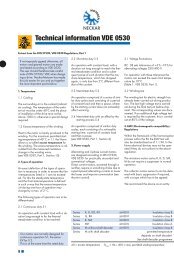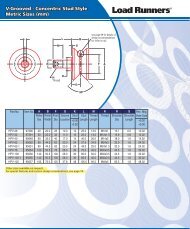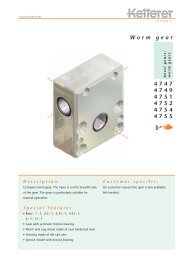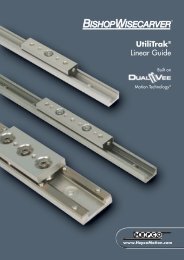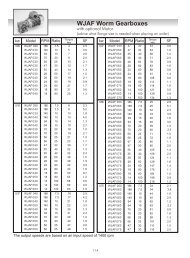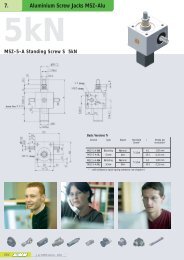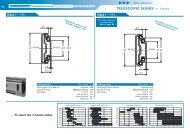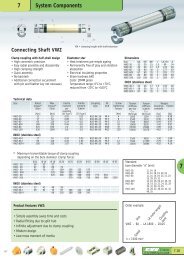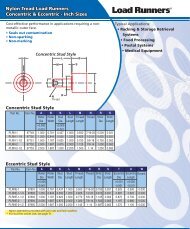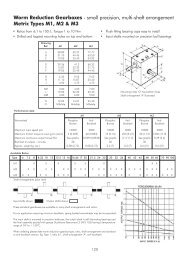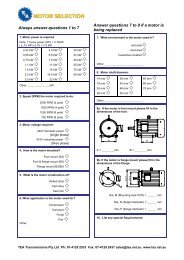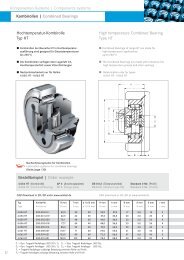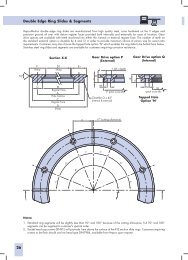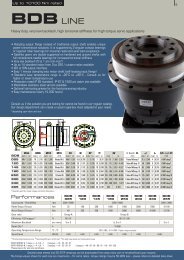Motors - TEA Machine Components Inc.
Motors - TEA Machine Components Inc.
Motors - TEA Machine Components Inc.
You also want an ePaper? Increase the reach of your titles
YUMPU automatically turns print PDFs into web optimized ePapers that Google loves.
MOTOREN<br />
Technology<br />
Induction <strong>Motors</strong><br />
NECKAR<br />
All induction motors operate according to<br />
a uniform principle: The mechanically stationary<br />
“Stator“ produces a rotating magnetic<br />
field which is synchronised exactly<br />
with the frequency of the power supply.<br />
The rotor is made of low-loss magnetic<br />
steel which is surrounded by a cage made<br />
of short-circuited metal bars, (therefore also<br />
the name “squirrel-cage rotor “).<br />
During operation the stator induces a<br />
(therefore “induction motor“) torque produced<br />
magnetic field in the rotor, as long<br />
as this turns more slowly than the stator<br />
magnetic field. The difference in the speed<br />
of rotation between stator and rotor is<br />
called “slip“. The greater the slip, the<br />
greater also the induction and therefore<br />
the torque of the motor.<br />
This behaviour leads to a stabilisation near<br />
the nominal point, which with the right design<br />
leads to stable behaviour without the<br />
assistance of electronic controls.<br />
Induction motors are an important part of<br />
the NECKAR-MOTOREN- Programme. A<br />
single-phase capacitor motor normally has<br />
a lower starting torque as the rated torque.<br />
This should be taken into consideration<br />
during design.<br />
This is just the opposite to 3-phase current<br />
motors. Therefore the 3-phase current motor<br />
is preferred for applications with difficult<br />
start up.<br />
The following table shows the relationship of the starting torque to the rated torque.<br />
Single-phase motor<br />
3-phase motor<br />
2pole 0.60 x M rated 1.2 x M rated<br />
4pole 0.70 x M rated 1.3 x M rated<br />
8pole 0.85 x M rated 1.6 x M rated<br />
The typical torque characteristics can be seen in Fig. 1 and 2.<br />
The efficiency of these precision motors are as follows<br />
Single-phase motor<br />
3-phase motor<br />
2pole up to 63 % up to 72 %<br />
4pole up to 52 % up to 56 %<br />
8pole up to 29 % up to 35 %<br />
The resulting rated speeds for both types are then:<br />
You have the following benefits when<br />
using Neckar-Induction motors:<br />
With 3-phase current motors simple<br />
connection to the 3-phase supply.<br />
With capacitance motors simple connection<br />
to the lighting circuit.<br />
High specific power volume.<br />
2pole 2600–2750 min –1<br />
4pole 1200–1300 min –1<br />
8pole 600– 650 min –1<br />
Rotation reversal by simply changing the<br />
poles.<br />
Extremely long service life only dependent<br />
on ball bearings.<br />
Because of our modular design all motors<br />
can be combined with various gears<br />
detectors, brakes etc.<br />
Extremely quite running in all load<br />
phases.<br />
you, too, will find your made-to-measure<br />
drive<br />
Md=Ncm<br />
K 662<br />
Md=Ncm<br />
K 662<br />
M stall<br />
M start<br />
M stall<br />
M start<br />
M rated<br />
Rated operation c=2.5 µF<br />
Rated operation λ<br />
Rated operation ∆ c=3 µF<br />
M rated<br />
M start<br />
Figure 1 Figure 2<br />
For data sheets see page 27–38<br />
18 ■


